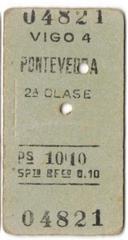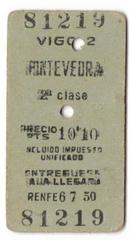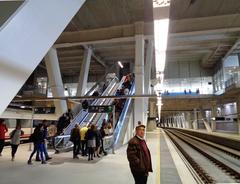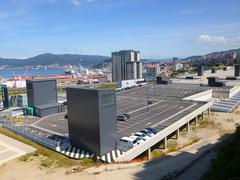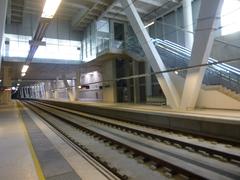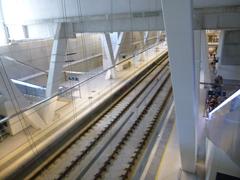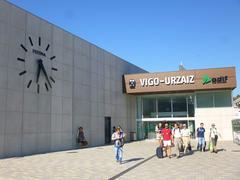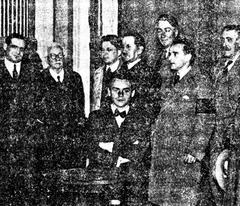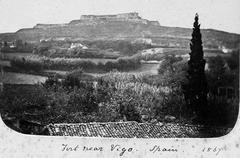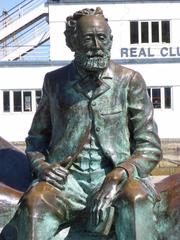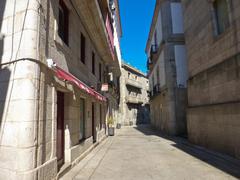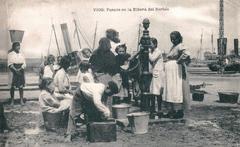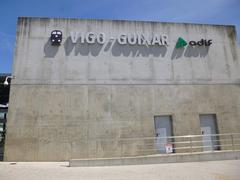
Vigo Railway Station Visiting Hours, Tickets, and Travel Guide
Date: 14/06/2025
Introduction to Vigo Railway Station and Its Significance
Vigo Railway Station, now officially known as the Vialia Vigo Intermodal Station, stands at the heart of Galicia’s modern transport network and urban identity. Tracing its origins to 1878 with the original Vigo-Urzáiz station, this hub has played a central role in transforming Vigo from a growing maritime port into Galicia’s largest city. The arrival of the railway accelerated economic and industrial development across the region, forging connections between Vigo, inland Galicia, and national and international destinations (Wikipedia: Vigo-Urzáiz railway station).
The station’s evolution, culminating in the 21st century with a dual-station system—Vigo-Urzáiz for high-speed AVE services and Vigo-Guixar for conventional and international trains—demonstrates the city’s adaptation to changing travel demands (Seat61: Vigo Stations). The 2015 opening of the new Vigo-Urzáiz station and the launch of the Vialia Vigo complex in 2023, designed by Morphosis Architects, have transformed the station into a landmark of contemporary architecture and urban life. Today, it offers not only seamless multimodal transport but also a dynamic mix of shopping, leisure, and public spaces (Designboom: Vialia Vigo Intermodal Station; The Plan).
Travelers will find extensive amenities, high-speed and regional ticketing, full accessibility, and direct links to city buses and the airport. The station’s sustainable design and heritage elements, alongside its proximity to attractions like the Vigo Railway Museum and the Fortress of San Sebastián, make it a model for modern European railway hubs and a rewarding destination in itself (Eurail; Bella Travel: Vigo Railway Museum; Discovering Vigo).
This comprehensive guide covers the station’s history, architecture, visiting hours, tickets, accessibility, nearby attractions, and essential travel tips to ensure a smooth and memorable visit to Vigo Railway Station.
Table of Contents
- Origins and Early Development of Vigo Railway Station
- Transition and Expansion: The Dual Station System
- Modernization and the Arrival of High-Speed Rail
- Architectural Innovation: The Vialia Vigo Intermodal Complex
- Technological Advancements and Passenger Experience
- Visiting Hours and Tickets
- Heritage Preservation and Historical Sites
- Practical Visitor Information
- Frequently Asked Questions (FAQ)
- Architectural Vision and Urban Integration
- Accessibility and User Experience
- Nearby Attractions
- Special Events and Guided Tours
- Exploring the Fortress of San Sebastián
- Summary and Recommendations
- Sources and Further Reading
Origins and Early Development of Vigo Railway Station
The city’s railway story began in 1878 with the construction of the Vigo-Urzáiz station. On June 18, 1881, the first train departed for Ourense, marking the start of regular railway service in Vigo and connecting it to Spain’s expanding rail network (Wikipedia: Vigo-Urzáiz railway station). For over a century, the station facilitated the movement of goods and people, underpinning Vigo’s growth as a leading port and industrial city (Nomads Travel Guide).
Transition and Expansion: The Dual Station System
With increasing rail traffic and the need for modernization, Vigo adopted a dual-station system in the early 21st century:
- Vigo-Urzáiz: The historic main station, rebuilt for high-speed AVE services.
- Vigo-Guixar: Opened to handle conventional and international routes, such as the Celta Express to Porto, Portugal (Seat61: Vigo Stations; Rail.cc: Vigo-Guixar).
Vigo-Guixar became the main station for regional and international routes during the reconstruction of Urzáiz, ensuring uninterrupted rail service (Turismo de Vigo).
Modernization and the Arrival of High-Speed Rail
The construction of the new Vigo-Urzáiz station marked the city’s entry into Spain’s high-speed AVE network, as part of the Atlantic Axis project linking major Galician cities (Wikipedia: Vigo-Urzáiz railway station). Opened in April 2015, the station features six underground platforms for high-speed trains, with upper levels devoted to shopping and leisure (Seat61: Vigo Stations; Designboom: Vialia Vigo Intermodal Station).
As an intermodal hub, the station integrates train, bus, taxi, cycling, and pedestrian networks. City buses (notably line 9A to the airport) and cycling lanes connect directly to the station (Designboom: Vialia Vigo Intermodal Station).
Architectural Innovation: The Vialia Vigo Intermodal Complex
Designed by Thom Mayne of Morphosis Architects, the Vialia Vigo Intermodal Station is more than a transportation node—it’s a vibrant urban destination (Wikipedia: Vigo-Urzáiz railway station; Designboom: Vialia Vigo Intermodal Station). The complex features:
- A 30,000 m² public plaza with panoramic sea views and landscaped gardens.
- Vialia shopping center with 125 shops, restaurants, and entertainment options.
- A distinctive metal canopy and a reconstructed historic façade, blending contemporary design with Vigo’s heritage (The Plan).
Careful attention to sustainability, natural light, and user experience make the station a model for European transport design.
Technological Advancements and Passenger Experience
Vigo-Urzáiz features advanced security protocols, including X-ray luggage scanners and platform ticket checks—aligning with standards at major European stations (Seat61: Vigo Stations). Digital information displays, accessible facilities, and comfortable waiting areas enhance passenger comfort. Integration with the Vialia shopping center provides a full range of services from dining to business lounges.
Visiting Hours and Tickets
- Station Hours: Generally open from 5:00 AM to 12:00 AM (midnight).
- Ticketing: Purchase tickets for high-speed AVE and regional trains online via Renfe, at station counters, or at self-service kiosks. Advance booking is recommended during busy periods.
- Accessibility: Full accessibility features include elevators, ramps, and tactile paths.
- Travel Tip: Arrive at least 30 minutes before departure for security checks. For international routes (e.g., to Porto), use Vigo-Guixar station.
Heritage Preservation and Historical Sites
While the original 19th-century Urzáiz station was demolished, Vigo honors its railway legacy through the Vigo Railway Museum (Museo del Ferrocarril de Vigo). The museum features historic locomotives, model trains, and interactive exhibits, making it a highlight for visitors interested in the city’s railway past (Bella Travel: Vigo Railway Museum).
Practical Visitor Information
- Connections: Frequent high-speed trains link Vigo with A Coruña, Santiago de Compostela, Pontevedra, and Madrid.
- Central Location: The station is near Vigo’s historic center, port, and beaches.
- Transfers: Vigo-Guixar (for conventional/international trains) is within walking distance of Vigo-Urzáiz (Turismo de Vigo; Seat61: Vigo Stations).
Frequently Asked Questions (FAQ)
Q: What are the station’s opening hours?
A: Vigo-Urzáiz is open daily from 5:00 AM to midnight.
Q: Where can I buy tickets?
A: Online via Renfe, at station counters, or at self-service kiosks.
Q: How do I reach the airport?
A: City bus line 9A connects the station to Vigo Airport.
Q: Is the station accessible?
A: Yes, with elevators, ramps, and tactile paths for those with reduced mobility.
Q: What is the difference between Vigo-Urzáiz and Vigo-Guixar?
A: Urzáiz serves high-speed AVE trains; Guixar handles conventional and international trains.
Q: Are historical sites nearby?
A: Yes, including the Vigo Railway Museum and the Fortress of San Sebastián.
Architectural Vision and Urban Integration
Vialia Vigo is set on a dramatic urban site with a 17-meter elevation difference, bridging hillside neighborhoods and the city center (The Plan). The metal canopy and reconstructed façade pay homage to Vigo’s past while fostering a bold, contemporary identity. The station’s roof plaza, gardens, and public amenities have transformed it into a true urban gathering place.
Accessibility and User Experience
- Mobility: Elevators, escalators, barrier-free routes, and the Atendo assistance service provide easy navigation for all.
- Wayfinding: Clear signage and open sightlines facilitate movement.
- Amenities: Luggage lockers, ATMs, Wi-Fi, and tourist information are readily available (Eurail).
Nearby Attractions
- Castro Fortress: Offers sweeping views of the city and bay, about 2 km from the station.
- Old Town (Casco Vello): Lively plazas, bars, and historic buildings, within walking distance.
- Vigo Maritime Museum: Near the port, showcasing Vigo’s maritime history.
Special Events and Guided Tours
The station and its plaza host occasional markets, exhibitions, and festivals. Guided tours focusing on the architecture and history of the area are available seasonally—consult the official tourism website for schedules.
Exploring the Fortress of San Sebastián
History and Significance
Built in the 17th century to defend Vigo against attacks, the Fortress of San Sebastián is a symbol of the city’s maritime and military heritage. Its strategic location provided a vantage point over the harbor and has witnessed centuries of local history.
Visiting Hours and Tickets
- Opening Hours: Daily, 10:00 AM–7:00 PM (extended in summer).
- Admission: €5 for adults, with discounts for seniors, students, and children. Family passes and guided tours available.
Accessibility and Getting There
Accessible by local bus (VITRASA), taxi, or a scenic walk/cycle from the city center. The site includes ramps and tactile paving, with additional support available upon request.
Visitor Experience
Facilities include a visitor center, restrooms, a café, and Wi-Fi. The fortress offers panoramic views and is a favorite for photography.
Tips
- Book tickets online for preferred time slots.
- Wear comfortable shoes for uneven terrain.
- Check the Vigo tourism website for event updates.
Visual Highlights
Modern entrance of Vigo-Urzáiz station, illustrating its architectural excellence.
The lively Vialia shopping center within the station complex.
Historic locomotive at the Vigo Railway Museum.
Summary and Visitor Recommendations
Vigo Railway Station exemplifies the city’s blend of historical legacy and innovative urban design, positioning it as a gateway for Galicia and Spain. The seamless integration of high-speed, regional, and international trains—alongside vibrant commercial spaces and public amenities—ensures an efficient and enjoyable experience for all travelers (Wikipedia: Vigo-Urzáiz railway station; Designboom: Vialia Vigo Intermodal Station; The Plan; Eurail).
Nearby historical sites such as the Fortress of San Sebastián and the Vigo Railway Museum add depth to your visit, offering insight into the city’s maritime and railway heritage (Bella Travel: Vigo Railway Museum; Discovering Vigo). Plan your journey with the Audiala app for up-to-date schedules and travel tips, and explore more through our related articles and social media channels.
Sources and Further Reading
- This guide is based on information from:



